The heatwave has won this time, readers. The plan this year… oh god, let’s not talk about The Plan, it’s too upsetting. For several years now, we’ve fought back the heatwave with a low-intensity strategy game, defying the evil fire orb with games that are manageable even for a brain composed partially of plasma. I’d hoped, this year, to move beyond, and fight back the sky with three such games. But. It warm.
Still, you’re getting two. This year’s Low-Intensity Games For To Do Strategy Despite Grotesque Hot are Hyper Empire and High Strategy: Oradros.
Both are lightweight, quick-play games by design. Close as I’ve come to being devoured by Captain of Industry or the recent-ish Zephon DLC, I am having a pretty horrible time, and today’s recommendations might well double as year-round micro-hits of strategamine to keep us both from overdoing it as we both know we’re prone to. It’s okay, reader. We must work with ourselves.
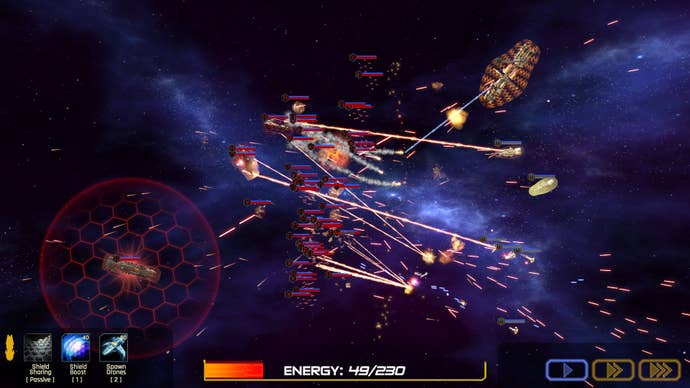
So. First up, it’s Hyper Empire. Space is there, so you must build spaceships and spacefight some other spacemen to secure spacevictory. This means building infrastructure that generates resources, and building spaceships with those. There’s a faint similarity to the tower defence dynamic here, as you establish the basic economic foundation then aim for the right balance between reinvesting and building up the fleet. There are enemy attacks every so many turns, whose escalation marks out how well you’re doing. The maths make growth near inevitable, and merely surviving for enough turns counts as an “endurance” win, so it becomes a question of how fast you can snowball, and gunning for alternative victories like amassing spacerocks or spaceresearch.
Each of its five factions has unique ships, strengths, and economics (unfortunately you can’t see much information about the enemy’s), and access to two upgrade trees via research or “faith”, some of which are uselessly trivial if unlocked later but a significant boon early on. The relationship between various installations is just complex enough to reward familiarity without demanding it, adding up to enough replay value for every faction to be worth a few experiments with a different emphasis or different capital ship loadout.
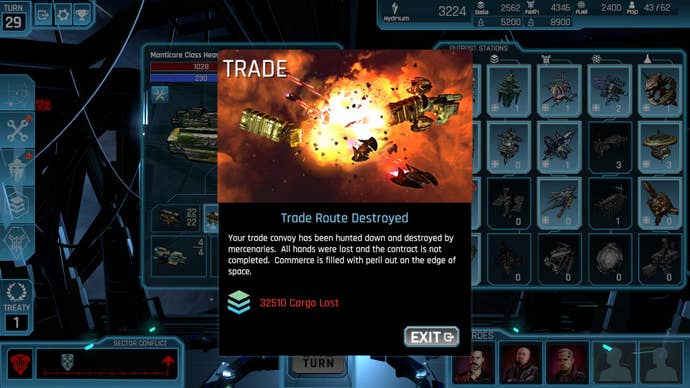

Oh, right, yeah. You get to watch the battles. Much as in Songs Of Silence, when you defend or attempt to conquer a sector (and if you’re the pirates, you attack a convoy) you’re treated to an auto-battle where everything you’ve built starts blasting. Control is limited to a formation system and firing off the flagship’s powers, and truth be told, there’s minimal feedback. But this is mostly spectacle as reward. Unfortunately though, a strategy game hobby makes us superior megabrained genius people who are above getting any satisfaction from watching a cool spaceship light show.
Normally I’d play this kind of game once or twice, get the idea, and not feel like going through the motions again. Hyper Empire feels different. Sitting back to enjoy the battles has obvious appeal, but there’s also the underrated factor of its interface feeling nice (plus some mildly charming animations, like one faction’s robot feeding population icons into its maw when you convert them into data), and above all its lack of timewasting. Everything is instant (except trade, which gambles resources against a delayed payoff/loss that makes things less purely additive), and emphasises fast and loose decision making. It’s okay to be sub-optimal, it’s okay to have everything wiped out if you can replace it. It’s lightweight, but not weightless. But what if we took out the spectacle? What if you never even saw your armies? What if I stopped listing contrasts and got on with the next one? Well, fine.
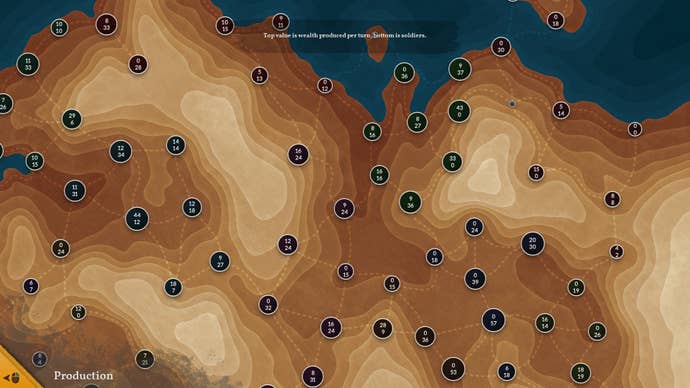
High Strategy Colon Oradros is another that I half expected to enjoy once, and leave it at that. Instead, its playthroughs are short and easy enough for a few clicks to get you several turns in, and by then you might as well see where it goes.
When I say its armies can include slingers and firelancers and several dinosaurs, I should ward against disappointment, since that detail is purely for flavour. All its cultures, factions, and soldiers carry brief but colourful descriptions, but in practice it’s all basically irrelevant, and seldom noticed when you’re conquering and reorganising things. I like that it’s there. It adds the lightest of flavours to a game that pares down the fiddly, overwhelming grand strategy detail, condensing every turn into a strict rule: you can take one action.
You must conquer 5 specific cities before the turn limit. Each of 40 factions has a unique position and targets to pursue in local conflicts, while the simulated world mostly never affects you. There are no limits to to how many cities you can hold… except the need to hold them. Unhappy ones may declare independence, or switch sides if sufficiently espionaged. Cities can be developed with administrative actions lasting several turns, and the more you have, the more you must defend. But defending takes up your action.
If two neighbours attack at once, you must choose. They operate by the same rules, so you can exploit that too, and tailor your army to best suit their terrain. Your army is made of five units of archers, spearmen, skirmishers, brontosarusesesi, or many more, each most effective on certain terrains. Attackers with a higher relative bonus are more likely to “break through” to victory, but undefended cities automatically fall.
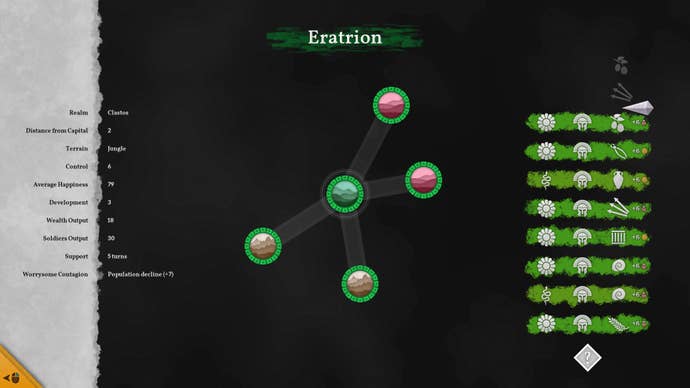
Available types aren’t determined by faction or production buildings, but by which cultures live within your realm. Every population point lives somewhere, producing one resource (automatically converted to money or growth, with some regional modifiers affecting e.g. grapes or ceramics), and claiming a warrior tradition that grants access to their flavour of wardude. But the useful new stablads you integrated will disappear if you lose the cities they live in, forcing you to reorganise the army. Unhappy people may also leave (or be forcibly displaced with an action – perhaps you lack the gold to placate them). Everyone also belongs to a sect that practices certain rituals, and once beyond basic familiarity, you’ll dig into an optional menu to choose one of these traditions to encourage and one to suppress. The obvious play is to make an already comfortable and dominant group slightly more comfortable in exchange for making a minority significantly worse off. What? No, I just like sharpening knives. Don’t worry about it. Vote!
You don’t have to manually recruit, just choose 5 fightman flavours to comprise your single army, with diminishing returns on experience gain for duplicates. Experience means improved performance on some terrains, but the available options vary, making some initially limited killboys a versatile investment if you do enough fighting.
Numbers can be bumped with a “recruit” action that burns a population point in the chosen city, more efficiently if you use “assert” first, at the cost of happiness. Then there’s trading with neighbours for mutual profit, more so if you set your attitude to “friendly”. Relations aren’t the usual peace/war or “+5 you have a cool hat!”; you can always see each neighbour’s attitude, and how much they covet your land, trust you, and consider you a threat. There’s no breakdown of why, nor diplomatic actions as such, making it impersonal but fairly unrestrictive; with no formal status, a tiny bit like Fragile Allegiance, relations are what you do. You’re not deathmatching with the AI, just trying to hit those 5 cities before the turn limit (which varies per faction!), so they act somewhat rationally, not playing “stop the human”.
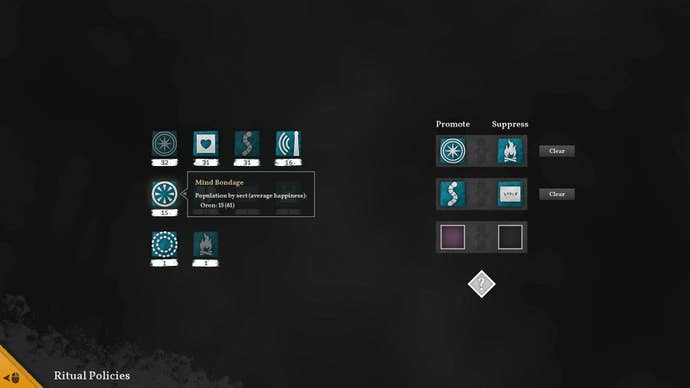
It sounds like an awful lot, doesn’t it? But this is a very simple game at heart, with minimal pondering. You can, and probably will, mostly ignore the details for a game or two, still mostly repeating similar patterns. Army goes up, conquer city, recruit, appease, change army, develop. But it all sits in the background, lending a little irregularity, some sense that you can try other things, that each faction could play out quite differently. I’ve struggled in a tiny corner for a whole game, finally coming within two battles of a full 5/5 win, only to lose two of them in terrain that my new army couldn’t retake. Another game saw a random plague hollow out half my land, exposing my complacency about my apparently inexhaustible army for a sudden era of retraction and fortifying.
Oradros is not a difficult game, but there’s enough dynamic simulation for surprises even if you don’t see it all, and although your income and army typically grow exponentially, there’s less sense of inevitability than usual, and it feels less arbitrary or unfair when you lose out. That crucial “one action per turn” system gives it just enough depth to make things interesting and hint at some reality to the world, while keeping it firmly within reach of that state of mind where you’re researching how cold a saline drip can be before it gets dangerous.
We’ll get you next time, Sun.







